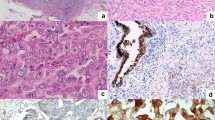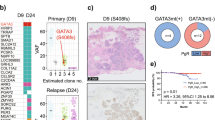Abstract
About 70–80% of breast cancers express estrogen receptor alpha (ER-α), and estrogens play important roles in the development and growth of hormone-dependent tumors. Together with lymph node metastasis, tumor size, and histological grade, ER status is considered as one of the prognostic factors in breast cancer, and an indicator for hormonal treatment. To investigate genes and pathways that are associated with ER status and epithelial cells in breast tumor, we applied laser capture microdissection (LCM) technology to capture epithelial tumor cells from 28 lymph node-negative breast tumor samples, in which 17 patients had ER-α+ tumors, and 11 patients have ER-α− tumors. Gene expression profiles were analysed on Affymetrix Hu133A GeneChip. Meanwhile, gene profiles using total RNA isolated from bulk tumors of the same 28 patients were also generated. In total, 146 genes and 112 genes with significant P-value and having significant differential expression between ER-α+ and ER-α− tumors were identified from the LCM data set and bulk tissue data set, respectively. A total of 61 genes were found to be common in both data sets, while 85 genes were unique to the LCM data set and 51 genes were present only in the bulk tumor data set. Pathway analysis with the 85 genes using Gene Ontology suggested that genes involved in endocytosis, ceramide generation, Ras/ERK/Ark cascade, and JAT-STAT pathways may play roles related to ER. The gene profiling with LCM-captured tumor cells provides a unique approach to study epithelial tumor cells and to gain an insight into signaling pathways associated with ER.
This is a preview of subscription content, access via your institution
Access options
Subscribe to this journal
Receive 50 print issues and online access
$259.00 per year
only $5.18 per issue
Buy this article
- Purchase on Springer Link
- Instant access to full article PDF
Prices may be subject to local taxes which are calculated during checkout



Similar content being viewed by others
References
Akhurst RJ, Derynck R . (2001). Trends Cell Biol 11: S44–S51.
Ammanamanchi S, Brattain MG . (2004). J Biol Chem 279: 32620–32625.
Binder LI, Frankfurter A, Rebhun LI . (1985). J Cell Biol 101: 1371–1378.
Chen JR, Plotkin LI, Aguirre JI, Han L, Jilka RL, Kousteni S et al. (2004). J Biol Chem 280: 4632–4638.
Eckert LB, Repasky GA, Ulku AS, McFall A, Zhou H, Sartor CI et al. (2004). Cancer Res 64: 4585–4592.
Emmert-Buck MR, Bonner RF, Smith PD, Chuaqui RF, Zhuang Z, Goldstein SR et al. (1996). Science 274: 998–1001.
Fernando RI, Wimalasena J . (2004). Mol Biol Cell 15: 3266–3284.
Foekens JA, Portengen H, van Putten WL, Peters HA, Krijnen HL, Alexieva-Figusch J et al. (1989). Cancer Res 49: 5823–5828.
Fox BP, Kandpal RP . (2004). Biochem Biophys Res Commun 318: 882–892.
Gamallo C, Moreno-Bueno G, Sarrió D, Calero F, Hardisson D, Palacios J . (2001). Mod Pathol 14: 650–654.
Gruvberger S, Ringner M, Chen Y, Panavally S, Saal LH, Borg A et al. (2001). Cancer Res 61: 5979–5984.
Hall JM, Couse JF, Korach KS . (2001). J Biol Chem 276: 36869–36872.
Kamme F, Zhu J, Luo L, Yu J, Tran DT, Meurers B et al. (2004). Methods Mol Med 99: 215–223.
Khoo C, Blanchard RK, Sullivan VK, Cousins RJ . (1997). Protein Exp Purif 9: 379–387.
Kim H, Xu J, Su Y, Xia H, Li L, Peterson G et al. (2001). Biochem. Soc. Trans. 29: 216–222.
Komuro A, Imamura T, Saitoh M, Yoshida Y, Yamori T, Miyazono K et al. (2004). Oncogene 23: 6914–6923.
Luo L, Salunga RC, Guo H, Bittner A, Joy KC, Galindo JE et al. (1999). Nat Med 5: 117–122.
Luzzi V, Mahadevappa M, Raja R, Warrington JA, Watson MA . (2003). J Mol Diagn 5: 9–14.
Ma XJ, Salunga R, Tuggle JT, Gaudet J, Enright E, McQuary P et al. (2003). Proc Natl Acad Sci USA 100: 5974–5979.
Malbert-Colas L, Fay M, Cluzeaud F, Blot-Chabaud M, Farman N, Dhermy D et al. (2003). Pflugers Arch 447: 35–43.
Mandlekar S, Kong AN . (2001). Apoptosis 6: 469–477.
Marinkovich MP, Taylor TB, Keene DR, Burgeson RE, Zone JJ . (1996). J Invest Dermatol 106: 734–738.
Matsuda T, Yamamoto T, Muraguchi A, Saatcioglu F . (2001). J Biol Chem 276: 42908–42914.
Matsui H, Suzuki K, Hasumi M, Koike H, Okugi H, Nakazato H et al. (2003). Anticancer Res 23: 195–200.
Moggs JG, Orphanides G . (2001). EMBO Rep 2: 775–781.
Mokbel K . (2003). Curr Med Res Opin 19: 683–688.
Nakamura T, Furukawa Y, Nakagawa H, Tsunoda T, Ohigashi H, Murata K et al. (2004). Oncogene 23: 2385–2400.
Nishidate T, Katagiri T, Lin ML, Mano Y, Miki Y, Kasumi F et al. (2004). Int J Oncol 25: 797–819.
Paredes J, Stove C, Stove V, Milanezi F, Van Marck V, Derycke L et al. (2004). Cancer Res 64: 8309–8317.
Parl FF . (2000). Estrogens, Estrogen Receptor and Breast Cancer. IOS Press: Ohmsha Amsterdam.
Perou CM, Sørlie T, Eisen MB, van de Rijn M, Jeffrey SS, Rees CA et al. (2000). Nature 406: 747–752.
Polacek DC, Passerini AG, Shi C, Francesco NM, Manduchi E, Grant GR et al. (2003). Physiol Genomics 13: 147–156.
Poliakov A, Cotrina M, Wilkinson DG . (2004). Dev Cell 7: 465–480.
Rae JM, Johnson MD, Scheys JO, Cordero KE, Larios JM, Lippman ME . (2005). Breast Can Res Treat 92: 141–149.
Seth A, Kitching R, Landberg G, Xu J, Zubovits J, Burger AM . (2003). Anticancer Res 23: 2043–2051.
Simstein R, Burow M, Parker A, Weldon C, Beckman B . (2003). Exp Biol Med 228: 995–1003.
Sotiriou C, Neo SY, McShane LM, Korn EL, Long PM, Jazaeri A et al. (2003). Proc Natl Acad Sci USA 100: 10393–10398.
Spillantini MG, Goedert M . (1998). Trends Neurosci 21: 428–433.
Sun JM, Spencer VA, Li L, Yu Chen H, Yu J, Davie JR . (2005). Exp Cell Res 302: 96–107.
Tamimi Y, Lines M, Coca-Prados M, Walter MA . (2004). Invest Ophthalmol Vis Sci 45: 3904–3913.
van't Veer LJ, Dai H, van de Vijver MJ, He YD, Hart AAM, Mao M et al. (2002). Nature 415: 530–536.
Wang JW, Gamsby JJ, Highfill SL, More LB, Bloom GC, Yeatman TJ et al. (2004). Oncogene 23: 4089–4097.
Weisz A, Basile W, Scafoglio C, Altucci L, Bresciani F, Facchiano A et al. (2004). J Cell Physiol 200: 440–450.
West M, Blanchette C, Dressman H, Huang E, Ishida S, Spang R et al. (2001). Proc Natl Acad Sci USA 98: 11462–11467.
Wu K, Yang Y, Wang C, Davoli MA, D'Amico M, Li A et al. (2003). J Biol Chem 278: 51673–51684.
Wu L, Wu Y, Gathings B, Wan M, Li X, Grizzle W et al. (2003). J Biol Chem 278: 15192–15200.
Yim SH, Ward JM, Dragan Y, Yamada A, Scacheri PC, Kimura S et al. (2003). Toxicol Pathol 31: 295–303.
Author information
Authors and Affiliations
Corresponding author
Additional information
Supplementary Information accompanies the paper on Oncogene website (http://www.nature.com/onc).
Rights and permissions
About this article
Cite this article
Yang, F., Foekens, J., Yu, J. et al. Laser microdissection and microarray analysis of breast tumors reveal ER-α related genes and pathways. Oncogene 25, 1413–1419 (2006). https://doi.org/10.1038/sj.onc.1209165
Received:
Revised:
Accepted:
Published:
Issue Date:
DOI: https://doi.org/10.1038/sj.onc.1209165
Keywords
This article is cited by
-
Clinical implications of intrinsic molecular subtypes of breast cancer for sentinel node status
Scientific Reports (2021)
-
C6-Ceramide and targeted inhibition of acid ceramidase induce synergistic decreases in breast cancer cell growth
Breast Cancer Research and Treatment (2012)
-
Laser capture microdissection (LCM) and whole genome amplification (WGA) of DNA from normal breast tissue --- optimization for genome wide array analyses
BMC Research Notes (2011)
-
MPA-induced gene expression and stromal and parenchymal gene expression profiles in luminal murine mammary carcinomas with different hormonal requirements
Breast Cancer Research and Treatment (2011)
-
Protein pathway biomarker analysis of human cancer reveals requirement for upfront cellular-enrichment processing
Laboratory Investigation (2010)



